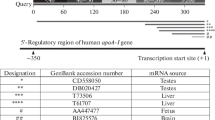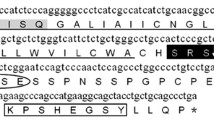Abstract
Apolipoprotein E (APOE), a component of lipoproteins plays an important role in the transport and metabolism of cholesterol, and is associated with hyperlipoproteinemia and Alzheimer’s disease. In order to further understand the characterization of APOE gene, the promoter of APOE gene of Landrace pigs was analyzed in the present study. The genomic structure and amino acid sequence in pigs were analyzed and found to share high similarity in those of human but low similarity in promoter region. Real-time PCR revealed the APOE gene expression pattern of pigs in diverse tissues. The highest expression level was observed in liver, relatively low expression in other tissues, especially in stomach and muscle. Furthermore, the promoter expressing in Hepa 1–6 was significantly better at driving luciferase expression compared with C2C12 cell. After analysis of porcine APOE gene promoter regions, potential transcription factor binding sites were predicted and two GC signals, a TATA box were indicated. Results of promoter activity analysis indicated that one of potential regulatory elements was located in the region −669 to −259, which was essential for a high expression of the APOE gene. Promoter mutation and deletion analysis further suggested that the C/EBPA binding site within the APOE promoter was responsible for the regulation of APOE transcription. Electrophoretic mobility shift assays also showed the binding site of the transcription factor C/EBPA. This study advances our knowledge of the promoter of the porcine APOE gene.







Similar content being viewed by others
References
Ang LS, Cruz RP et al (2008) Apolipoprotein E, an important player in longevity and age-related diseases. Exp Gerontol 43:615–622
Sabaretnam T, O’Reilly J et al (2010) The effect of old age on apolipoprotein E and its receptors in rat liver. Age (Dordr) 32:69–77
Mahley RW (1988) Apolipoprotein E: cholesterol transport protein with expanding role in cell biology. Science 240:622–630
Srivastava RA (1996) Regulation of the apolipoprotein E by dietary lipids occurs by transcriptional and post-transcriptional mechanisms. Mol Cell Biochem 155:153–162
Durliat M, Andre M et al (2000) Conserved protein motifs and structural organization of a fish gene homologous to mammalian apolipoprotein E. Eur J Biochem 267:549–559
Lahiri DK, Sambamurti K et al (2004) Apolipoprotein gene and its interaction with the environmentally driven risk factors: molecular, genetic and epidemiological studies of Alzheimer’s disease. Neurobiol Aging 25:651–660
Jellinger KA (2002) Alzheimer disease and cerebrovascular pathology: an update. J Neural Transm 109:813–836
Smith JD (2002) Apolipoproteins and aging: emerging mechanisms. Ageing Res Rev 1:345–365
Li S, Zhang H et al (2011) A functional mutation at position -155 in porcine APOE promoter affects gene expression. BMC Genet 12:40
Ramsoondar JJ, Rucker EB et al (1998) Isolation and genetic characterization of the porcine apolipoprotein E gene. Anim Genet 29:43–47
Brzozowska A, Grimholt U et al (1993) The sequence of porcine apolipoprotein E (APOE) cDNA. DNA Seq 4:207–210
Kuryl J (1999) Phenotyping of porcine apolipoprotein E using isoelectric focusing and localization of the APOE gene within the halothane-susceptibility linkage group. Biochem Genet 37:281–287
Zhang N, Jing W et al (2011) Molecular characterization and NF-kappaB-regulated transcription of selenoprotein S from the Bama mini-pig. Mol Biol Rep 38:4281–4286
Landschulz WH, Johnson PF et al (1988) Isolation of a recombinant copy of the gene encoding C/EBP. Genes Dev 2:786–800
Rossi V, Rouayrenc JF et al (1992) Analysis of proteins binding to the proximal promoter region of two rat serine protease inhibitor genes. Nucleic Acids Res 20:1061–1068
Ortiz BD, Krensky AM et al (1996) Kinetics of transcription factors regulating the RANTES chemokine gene reveal a developmental switch in nuclear events during T-lymphocyte maturation. Mol Cell Biol 16:202–210
Livak KJ, Schmittgen TD (2001) Analysis of relative gene expression data using real-time quantitative PCR and the 2(-Delta Delta C(T)) Method. Methods 25:402–408
Wang H, Yang S et al (2007) NF-kappaB mediates the transcription of mouse calsarcin-1 gene, but not calsarcin-2, in C2C12 cells. BMC Mol Biol 8:19
Geng H, Law PP et al (2011) APOE genotype-function relationship: evidence of -491 A/T promoter polymorphism modifying transcription control but not type 2 diabetes risk. PLoS One 6:e24669
Mahley RW, Rall SC Jr (2000) Apolipoprotein E: far more than a lipid transport protein. Annu Rev Genomics Hum Genet 1:507–537
Mahley RW, Huang Y (1999) Apolipoprotein E: from atherosclerosis to Alzheimer’s disease and beyond. Curr Opin Lipidol 10:207–217
Oh JY, Nam YJ et al (2010) Apolipoprotein E mRNA is transported to dendrites and may have a role in synaptic structural plasticity. J Neurochem 114:685–696
Zannis VI, Breslow JL et al (1982) Proposed nomenclature of apoE isoproteins, apoE genotypes, and phenotypes. J Lipid Res 23:911–914
Yerle M, Gellin J et al (1990) Localization on pig chromosome 6 of markers GPI, APOE, and ENO1, carried by human chromosomes 1 and 19, using in situ hybridization. Cytogenet Cell Genet 54:86–91
Paterson JM, Morton NM et al (2004) Metabolic syndrome without obesity: Hepatic overexpression of 11beta-hydroxysteroid dehydrogenase type 1 in transgenic mice. Proc Natl Acad Sci U S A 101:7088–7093
Lyons SE, Shue BC et al (2001) Molecular cloning, genetic mapping, and expression analysis of four zebrafish c/ebp genes. Gene 281:43–51
Kaestner KH, Christy RJ et al (1990) Mouse insulin-responsive glucose transporter gene: characterization of the gene and trans-activation by the CCAAT/enhancer binding protein. Proc Natl Acad Sci U S A 87:251–255
Acknowledgments
This research was supported by the National Key Technology Support Program (2012BAI39B04, 2011BAI15B02), The National Basic Research Program (2011CBA01005), National Science and Technology Major Project (2013ZX08010-003), National Natural Science Foundation of China (31372276), Innovation Project of Chinese Academy of Agricultural Sciences and The National High Technology Research and Development Program of China (SQ2011AAJY2795).
Disclosure Statement
The authors declare no competing interests.
Author information
Authors and Affiliations
Corresponding author
Rights and permissions
About this article
Cite this article
Xia, J., Hu, B., Mu, Y. et al. Molecular cloning and characterization of the promoter region of the porcine apolipoprotein E gene. Mol Biol Rep 41, 3211–3217 (2014). https://doi.org/10.1007/s11033-014-3182-x
Received:
Accepted:
Published:
Issue Date:
DOI: https://doi.org/10.1007/s11033-014-3182-x




